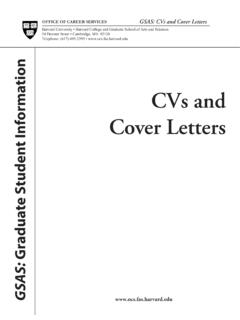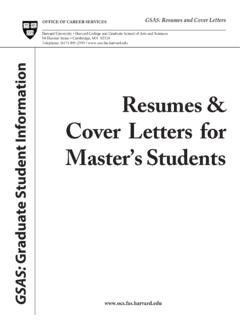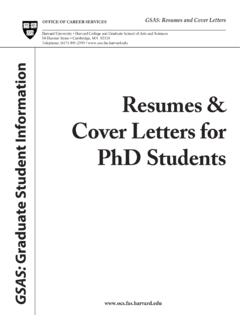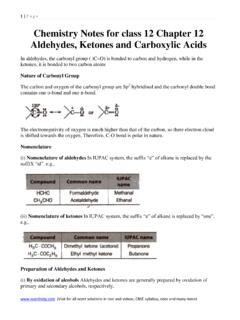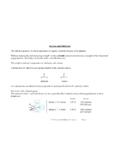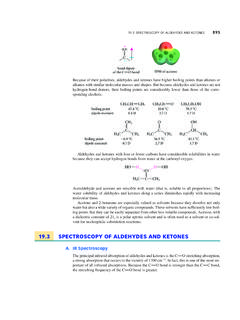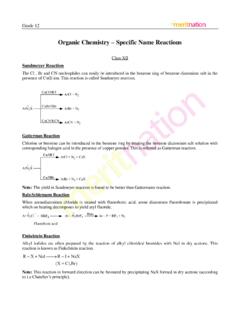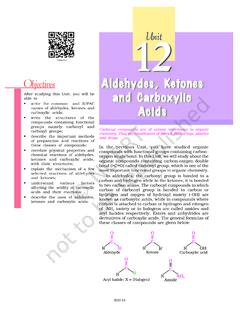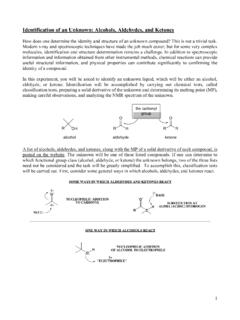Transcription of Myers Chem 115 C N Bond-Forming Reactions: Reductive …
1 Jonathan William Medley, Fan LiuReviews: MyersChem 115 Abel-Magid, A. F.; Mehrman, S. J. Org. Proc. Res. Devel. 2006, 10, 971 , A. F.; Carson, K. G.; Harris, B. D.; Maryanoff, C. A.; Shah, R. D. J. Org. Chem. 1996, 61, , S. Tetrahedron Lett. 1994, 35, 2401 2404. Hutchins, R. O.; Hutchins, M. K., Reduction of CdN to CHNH by Metal Hydrides. In Comprehensive Organic Synthesis; Trost, B. N., Fleming, I., Eds.; Pergamon Press: New York, 1991; Vol. 8. C!N Bond-Forming reactions : Reductive AminationReductive amination is a powerful and reliable strategy for the formation of C N bonds, and can avoid the problem of overalkylation that often accompanies direct alkylation of amines with alkyl amination involves a one- or two-step procedure in which an amine and a carbonyl compound condense to afford an imine or iminium ion that is reduced in situ or subsequently to form an amine :R1R2 ONR4R3R1R2NR3R4 HOR1R2NR3R4H+ (cat.)
2 R1R2NR3R4 HhydridesourceR1, R2, R3, R4 = H, alkyl, aryl!H2OR4 = HR1R2NR3hydride, proton sourceReduction with Sodium Cyanoborohydride:+ Borch and co-workers showed that sodium cyanoborohydride and lithium cyanoborohydride are acid-stable reagents capable of rapidly reducing carbonyl compounds to alcohols at pH 3 4, presumably via a protonated carbonyl 3, 23 C, 1 h93%OOHCH3 PhPhCH3( ) At pH 7, reduction of carbonyl compounds with lithium cyanoborohydride is very slow, even at reflux in pH 7, reflux, 72 h36%OOHCH3 PhPhCH3( )Borch, R. F.; Bernstein, M. D.; Durst, H. D. J. Am. Chem.
3 Soc. 1971, 93, 2897 , R. F.; Durst, H. D. J. Am. Chem. Soc. 1969, 91, 3996 : The Reductive amination of aldehydes and ketones is an important method for the synthesis of primary, secondary, and tertiary Agents Iminium ions are reduced selectively in the presence of their carbonyl precursors. Reagents such as sodium cyanoborohydride and sodium triacetoxyborohydride react selectively with iminium ions and are frequently used for Reductive relative rates of Reductive amination:H2 NRn>>> Common reducing agents: NaCNBH3, Na(OAc)3BH, H2/catalystNHn = 1, 2 HNR2H2 NAr1 Jonathan William MedleyMyersChem 115C!
4 N Bond-Forming reactions : Reductive Amination With care to maintain a pH of 6 7, a mixture of a ketone or aldehyde reactant, an amine, and sodium cyanohydride provides products of Reductive amination selectively, without competitive reduction of the carbonyl 6 8,a 23 CBorch, R. F.; Bernstein, M. D.; Durst, H. D. J. Am. Chem. Soc. 1971, 93, 2897 compoundisolated yield (%)aThe pH was maintained by addition of HCl and/or KOH as needed using bromocresol green as an +R1R2NR3R4H Though the conditions of the Borch reduction are mild, sodium cyanoborohydride is highly toxic, as are its ( )HOH3 CCH3 HNHPhH3 CCH3NH35178 PhNH2 ONOHH66H2 NOHOPhCH3H3 CCH3NH290 NHCH3 PhCH3H3 CONO79 NOHHR eduction with Sodium Triacetoxyborohydride: Sodium triacetoxyborohydride has been found to be a highly selective reducing agent for Reductive amination; acetic acid is frequently employed as a proton donor.
5 This protocol is generally high yielding, highly functional group tolerant, and proceeds without release of cyanide salts. The substrate scope includes aromatic and aliphatic aldehydes , ketones, and primary and secondary amines. Ammonia can be employed successfully if used in large excess as its acetate (10 equiv)PhNH2 NONOHCNNCOOEt(i-Pr)2 NHHNEtOOEtNaHB(OAc)3 Methodcarbonyl compoundyield (%)aMethod I: ClCH2CH2Cl, AcOH (1!2 equiv), NaBH(OAc)3 ( ! equiv). Method II: ClCH2CH2Cl, NaBH(OAc)3 ( ! equiv). bEt3N ( ! equiv) added. cyield of HCl +methodaIIIIIIbIIIII968880c969588cyclohe ptanonecycloheptylamineHHNCOOEtHON(i-Pr) 2 ONNPhNHNPhCH3 NCH3 NHPhR1R2NR3R4H2 Jonathan William MedleyMyersChem 115 Reductive amination of carbonyl compounds with primary amines can be complicated by overalkylation.
6 In these cases, formation and isolation of the imine followed by reduction can prove to be a superior with Sodium Borohydride:Abdel-Magid, A. F.; Carson, K. G.; Harris, B. D.; Maryanoff, C. A.; Shah, R. D. J. Org. Chem. 1996, 61, 3849! !N Bond-Forming reactions : Reductive AminationR1R2OR3+R1R2NR3CH3 OHNaBH4!H2O It was found that the use of methanol as solvent allows for rapid (< 3h) and nearly quantitative imine formation from aldehydes without the need for dehydrating !15 minaldehydeyield (%)aamineproduct84aproducts isolated as HCl with Weakly Nucleophilic Amines:NaHB(OAc)3 Methodcarbonyl compoundyield (%)amineproductR1R2 ONR4R3+methodaaMethod III: ClCH2CH2Cl, AcOH (1 equiv), NaBH(OAc)3 ( equiv).
7 Method IV: ClCH2CH2Cl, AcOH (2!5 equiv), carbonyl compound ( !2 equiv), NaBH(OAc)3 ( ! equiv). byield of HCl salt. cEt3N ( equiv) (CH3)2 OCH3 OHCH3 OHOOOCH3CH3 OHOH3 CNaBH3CN CH3OH,NHOOOOCH3 OHCH3CH3 EtOCH2 OHOCH3ON(CH3)2 OCH3 OHCH3 OHOOOCH3CH3 OHOH3 CNOH3 CCHOCH3 AcONHOHOTBSNOHOTBSCH3 AcOH3 CNaBH3 CNCH3 OHNOTHPCO2 BnCO2 BnCO2t-BuHHNCO2 BnHOHCNOTHPCO2 BnCO2 BnCO2t-BuHHNH TFACO2 BnHONHCH3 PhPhHONCH3 PhPhHH3 CNaBH3 CNCH2 ONHOHCO2 HCO2 HHHNCO2 HHMark G. Charest, Fan LiuHosokawa, S.; Sekiguchi, K.; Hayase, K.; Hirukawa, Y.; Kobayashi, S. Tetrahedron Lett. 2000, 41, (AcO)3BH, Sn(OTf)24 MS, ClCH2CH2Cl, 0 CExamples in Synthesis+Matsubara, H.
8 ; Inokoshi, J.; Nakagawa, A.; Tanaka, H.; Omura, S. J. Antibiot. 1983, 36, '-deoxymugineic acidOhfune, Y.; Tomita, M.; Nomoto, K. J. Am. Chem. Soc. 1981, 103, , E. J.; Levin, J.; Overman, L. E. J. Am. Chem. Soc. 1988, 110, +1. H2, Pd/C, EtOH,H2O, HCl 2. TFAM yersChem 115C!N Bond-Forming reactions : Reductive Amination Formic acid can also be used as a hydride donor:H3CH3 CHOONCH3CH3 OHOOH3 COH3 COHCH3 OCH3 OHOCH3CH3 OHON(CH3)2CH3CH2O, HCO2 HCHCl3, 65 C71%HH3CH3 CHOONCH3CH3 OHOOH3 COH3 COHCH3 OCH3 OHOCH3CH3 OHON(CH3)2CH3H3 CDokic, S.; Kobrehel, G.; Lopotar, N.; Kamenar, B.; Nagl, A.
9 ; Mrvos, D. J. Chem. Res (S). 1988, William Medley MyersChem 115 In a complex transformation, a tryptamine derivative and an enantioenriched dialdehyde were combined to give a cyclic bis-hemiaminal interemediate; electrophilic activation with trifluoroacetic anhydride initiated a Mannich/Sakurai cascade. Subsequent iminium reduction with sodium cyanoborohydride afforded a pentacyclic diamine en route to (!) , H.; Satoh, H.; Matsumoto, K.; Sugimoto, K.; Fukuyama, T.; Tokuyama, H. Angew. Chem., Int. Ed. 2009, 48, 7600! !N Bond-Forming reactions : Reductive AminationA regioselective Reductive amination using sodium triacetoxyborohydride was employed in the construction of the pyrrolidine ring of (!)
10 -communesin A:He, F.; Bo, Y.; Altom, J.; Corey, E. J. J. Am. Chem. Soc. 1999, 121, 6771! (2 equiv)!TFACH3 CNR = CH2 COOi-PrNNRH3 COOCH3 HNaBH3CN(5 equiv)66%TFACF3 COOCF3 COO!CF3 COOTMSNNH3 COOCH3 HOO(!)-aspidophytine6 stepsNNOOCH3 HOO(+)-haplophytineCH3 NCH3 NOOHONNOOCH3 HNCH3 NOOMsOCH3CH3 NNOOCH3 HNCH3 NOOMsOHCHO, NaBH3 CNAcOHCH2Cl2, CH3OH0 " 23 C55%1. 1N NaOH, CH3OH, 60 K3Fe(CN)6, NaHCO3, t-BuOH, H2O, 70% (2 steps). Regio- and stereoselective indolenine reduction and Reductive methylation of two secondary amines was achieved using Borch conditions en route to (+) (OAc)34 steps(!)
